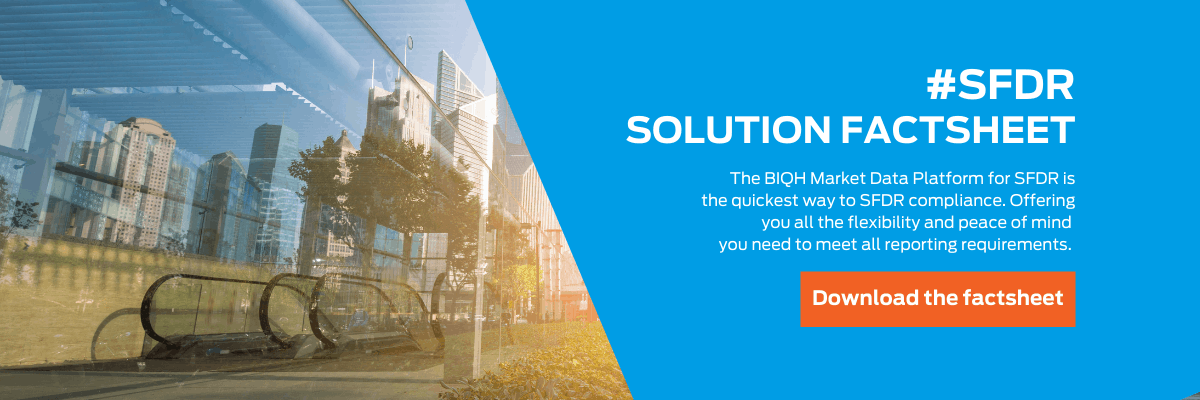As of March 2021 the new Sustainable Finance Disclosure Regulation [SFDR] came into effect. This regulation is developed to drive sustainable investment. The SFDR will have big impact on asset managers, banks and fund brokers. We offer you a complete blog series focusing on the SFDR, the obligations, the timelines, the definitions, the indicators and the Adverse Sustainability Impacts Statement to help you get your head around the subject. In our blog posts we focus on the impact of this regulation to you as a Financial Market Participant to ensure you are well prepared for the new regulation.
In this blog post we would like to inform you on recent developments of company reporting requirements on non-financial data such as environmental and governance data. This affects highly the availability of data needed to comply with SFDR obligations.
Status of EU sustainable finance legislation
As probably is the case with most legislation in development, the sustainable finance strategy adopted by the European Commission [the Commission] is scattered over several regulations, directives and other policies. There is a difference in the legal status of different levels of legislation. Policies that are categorized as ‘Regulation’ are binding legislative acts that are to be applied by each member state.
With regards to SFDR, this Regulation is referred to as Level 1 legislation. Derived from Regulations are implementation decisions like regulatory technical standards (RTS). These are referred to as Level 2 legislations. Please be referred to our Glossary on the technical difference between Level 1 and Level 2 legislation and the Lamfalussy Report that describes classification in the Union’s legal system.
Next to regulations the EU dictates ‘Directives’. Directives contain legislative acts that set out goals, but each member state is still allowed its own set of regulations to comply. An example in the context of SFDR is the Non-Financial Reporting Directive [NFRD] which recently is supplemented by the Corporate Sustainability Reporting Directive [CSRD].
Relationship between the SFDR, the TR and the NFRD
For Financial Market Participants [FMPs], when focussing on sustainability reporting requirements, the SFDR is leading. The implementation of SFDR is impacted by several other regulations though. Most predominantly this is affected by the Taxonomy Regulation [TR] which defines what is regarded as sustainable in this perspective. The TR came into force on 12 July 2020. This regulation provides standardized definitions and a system to classify whether an investment is to be considered sustainable or not. In addition, several articles of the TR will impose additional disclosure obligations under SFDR.
Regarding the ESG data that is needed to be able to comply with SFDR one can distinguish a demand and a supply side. The demand side is obviously populated by FMPs. They need to retrieve the relevant aggregated data on fund level. In order to execute this obligation the FMP needs to have access to a great amount of specific non-financial company information of the holdings of the fund. Now we are talking about the supply side of ESG data. In the EU, the company reporting obligations on sustainability metrics is initially regulated by the NFRD.
The NFRD regulation came already into effect in 2018 and requires corporates within the EU to disclose information on non-financial matters like ESG factors in their annual report or in a separate sustainability report. These rules only apply to large public-interest companies with more than 500 employees. Regarding the availability of company sustainability data, the majority of large caps within the EU is affected by this regulation. But finding data for small caps will be challenging. The same applies to companies located outside of the EU. Recently, on April 21 2021, the Commission launched a proposal to amend the NFRD in the form of an additional directive; the CSRD.
The intention of the pending Corporate Sustainability Reporting Directive
The CSRD is in full development at this time (August 2021). Effort has been made to set guidelines for companies reporting on sustainability. The CSRD aims to ensure alignment specifically with the SFDR and TR and to reduce complexity and potential duplicative reporting requirements. It ensures that companies report the information that investors and FMPs need. CSRD’s scope is much broader than only Blue Chip companies. It covers not only all European listed companies, but applies also for sufficiently large non-listed companies (Assets > € 20mln, Revenues > € 30 mln, Employees > 500). CSRD will broaden the current NFRD scope by at least four times and over 50,000 companies will be mandated under this directive. This enforces the breadth and depth of sustainability data to be able to comply with SFDR.
The directive introduces a general EU-wide audit requirement for reported sustainability information. Even more important for data availability, it dictates companies to include CSRD requirements in the company’s annual report. Companies are held to prepare statements and reports in XHTML format in order to tag their sustainability information according to a specified digital categorisation system. Sustainability issues a company is obligated to report on, will be expanded to how the company’s strategy relates to their sustainability goals. The concept of double materiality is set out to link sustainability goals to economic strategy.
Double materiality in the CSRD
Double materiality is an extension of the key accounting concept of materiality of financial information; when deciding whether an issue needs to be disclosed, you need to take into account that it must have sufficient impact or importance. For instance, the impact of a company’s pollutive activities may have material impact on the company’s performance in the long run, thus this needs to be disclosed. The concept of double materiality takes it one step further. Not just climate-related impacts on the company itself could be material, like in the example before, but also impacts of a company on the climate as a whole – or any other dimension of sustainability, could be required to be disclosed.
CSRD gives more guidelines on how to report and where to disclose sustainability information. It explicitly refers to the double materiality principle by stating an ‘outside-in perspective’ as well as an ’inside-out perspective’ when reporting on sustainability. The directive is currently reviewed by the European Parliament. It is clear that the Commission is making great haste with the directive by targeting 2023 as the first year member states need to have incorporated this directive in their legislation, requiring companies to report on CSRD in 2024.
The upcoming European Single Access Point [ESAP]
There is another interesting development regarding the availability of sustainability data. Later in 2021 the Commission will propose a Capital Markets Union Action Plan [CMU] where sustainability data can be incorporated in a European Single Access Point [ESAP] for company information. This ESAP not only aims to provide harmonized financial information, more or less like EDGAR does in the USA, but it also requires companies to provide non-financial information. It covers about thirty-three directives and regulations, from EMIR to SFDR, form credit ratings to accounting directives, most specifically for financial institutions.
ESAP consultation outcomes
After consultation, last May in 2021, market participants (mainly businesses) have given their feedback to the Commission about the ESAP. The most important outcomes of this feedback were:
- The information that respondents most commonly recommend to be provided in structured data formats and become machine-readable were the financial statements (86%), the half-year financial reports of listed companies (78%), sustainability-related information (73%), the management report (68%) and the audit report (58%).
- The European Single Electronic Format (ESEF) came on top of recommended IT formats, followed by XML and CSV.
- A web portal was the most supported means of access (81%), but there was also wide support for using Application Programming Interfaces [APIs] and for allowing bulk download.
- As regards to costs and benefits, respondents, notably preparer-users, were overall convinced (67%) that the benefits of the ESAP would outweigh its costs.
- The vast majority of respondents was in favour of access free of charge. Most were in favour that the ESAP should be financed by EU funds.
This development is clearly very promising for users of large bulk data like yourself. Though it will take some time for every aspect to be set in stone, several large market participants urge the Commission to prioritize the availability of sustainability data. As this has our full interest, we at BIQH will follow these events closely and are happy to inform you on any new developments.
We are always open for a chat and we encourage discussions, especially when it comes to financial market data. Let us know your challenges, questions and uncertainties relating to the Sustainable Finance Disclosure Regulation.


